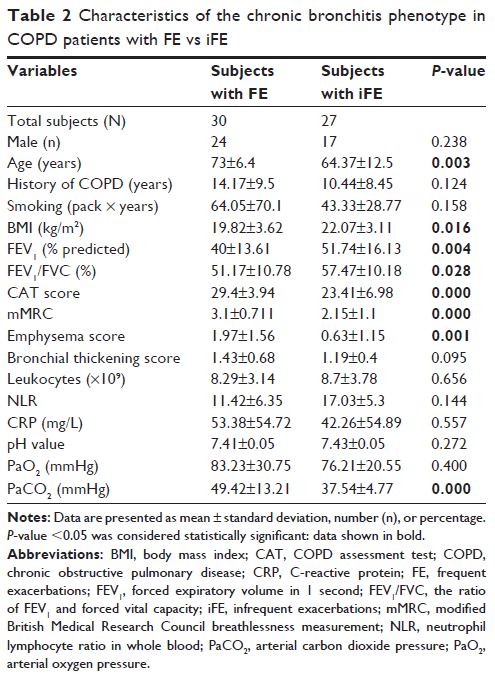100205
论文已发表
注册即可获取德孚的最新动态
IF 收录期刊
- 3.3 Breast Cancer (Dove Med Press)
- 3.4 Clin Epidemiol
- 2.5 Cancer Manag Res
- 2.9 Infect Drug Resist
- 3.5 Clin Interv Aging
- 4.7 Drug Des Dev Ther
- 2.7 Int J Chronic Obstr
- 6.6 Int J Nanomed
- 2.5 Int J Women's Health
- 2.5 Neuropsych Dis Treat
- 2.7 OncoTargets Ther
- 2.0 Patient Prefer Adher
- 2.3 Ther Clin Risk Manag
- 2.5 J Pain Res
- 2.8 Diabet Metab Synd Ob
- 2.8 Psychol Res Behav Ma
- 3.0 Nat Sci Sleep
- 1.8 Pharmgenomics Pers Med
- 2.7 Risk Manag Healthc Policy
- 4.2 J Inflamm Res
- 2.1 Int J Gen Med
- 4.2 J Hepatocell Carcinoma
- 3.7 J Asthma Allergy
- 1.9 Clin Cosmet Investig Dermatol
- 2.7 J Multidiscip Healthc

频繁发作 COPD 患者的慢性支气管炎、肺气肿和 ACOS 表型的临床特征
Authors Cheng YS, Tu XW, Pan LL, Lu S, Xing M, Li LL, Chen XW
Received 22 April 2017
Accepted for publication 19 June 2017
Published 18 July 2017 Volume 2017:12 Pages 2069—2074
DOI https://doi.org/10.2147/COPD.S140231
Checked for plagiarism Yes
Review by Single-blind
Peer reviewers approved by Dr Charles Downs
Peer reviewer comments 2
Editor who approved publication: Dr Richard Russell
Purpose: Chronic bronchitis (CB), emphysematous (EM) and asthma–chronic
obstructive pulmonary disease (COPD) overlap syndrome (ACOS) phenotypes in COPD
are well recognized. This study aimed to investigate distinguishing
characteristics of these phenotypes in COPD patients with frequent
exacerbations (FE).
Patients and methods: A retrospective study was carried out. COPD patients
with acute exacerbations were consecutively reviewed from November 2015 to
October 2016. Patients were divided into FE and infrequent exacerbations (iFE)
subgroups.
Results: A total of 142 eligible COPD subjects were reviewed.
In the CB phenotype subgroup, age, body mass index, forced expiratory volume in
1 second (FEV1) % predicted, COPD assessment
test (CAT), modified Medical Research Council breathlessness measurement (mMRC)
dyspnea scale, emphysema scores and arterial carbon dioxide pressure (PaCO2)
were significantly different in subjects with FE when compared to those in
subjects with iFE of CB. In the EM phenotype subgroup, age, CAT, mMRC scores
and history of COPD were different in subjects with FE when compared to those
in CB subjects with iFE. Multivariate analysis indicated that FEV1% predicted (odds ratio [OR] =0.90, P =0.04) and PaCO2 (OR =1.22, P =0.02)
were independent risk factors for FE in COPD with CB phenotype, and CAT (OR
=2.601, P =0.001) was the independent risk
factor for FE in COPD with EM phenotype. No significant differences in
characteristics were observed in ACOS phenotype subgroups with FE or iFE.
Conclusion: In CB or EM phenotypes, COPD patients with FE present
several differential clinical characteristics compared to patients with iFE,
while the characteristics of ACOS phenotype in patients with FE need more
investigation.
Keywords: chronic
bronchitis, emphysema, ACOS, COPD, frequent exacerbations
